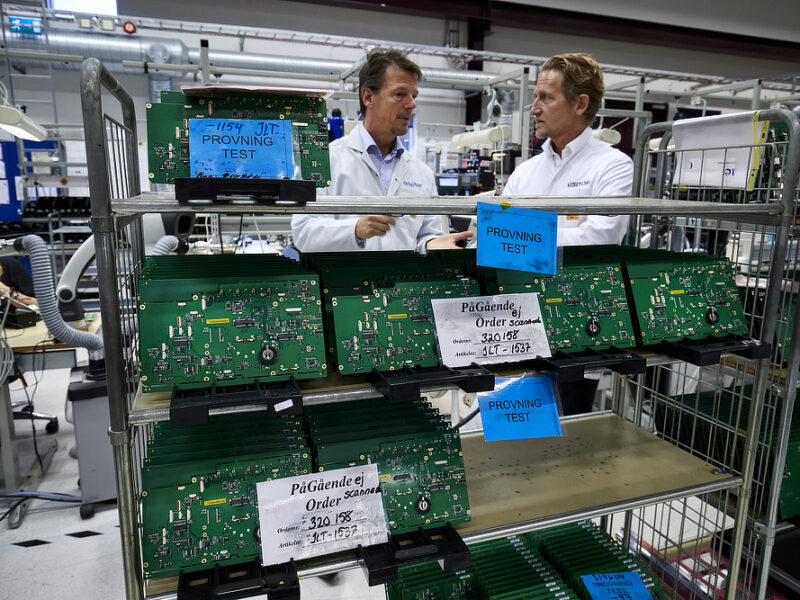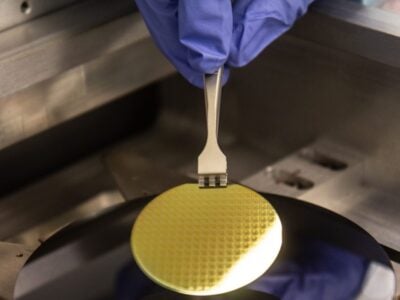
Manufacturing the future in Europe
JLT Mobile is Sweden’s largest PC manufacturing company, with over 100,000 computers shipped worldwide. It partners with a local supplier for its boards, building systems at its plant an hour from the capital Stockholm, which turned out to be a key advantage during the pandemic. But it is also looking to use its expertise in hardware to expand its data analysis services.
“This spring when we went into the pandemic one of the aspects we were looking at was our ability to fulfil customer orders as there were indications of longer lead times on items such as batteries,” said Per Holmberg, CEO of JLT (above right, at the headquarters in Ronneby). “So we decided to build up inventory here in Sweden on both components and finished products.”
“We worked closely with our manufacturing partner to make sure we had back up resources in case employees were sick or in quarantine but we have been able to keep the production cell running – its not that crowded but there is manual labour on testing, but we have been able to do that with multiple shifts so we had different teams coming in at different times.”
The company was started in 1994 in the early days of the Internet and GSM, pioneering the rugged computing market with its own engineering and manufacturing facilities in Sweden, enabling it to control every aspect of production with high precision.
Amid the Covid-19 pandemic, it has launched its first Android-based rugged computer system and is looking at using its hardware expertise to expand its services business into data analysis services.
“Currently we have all the manufacturing, both PCB design and manufacture as well as box build in Sweden about an hour from the headquarters. We manufacture the boards, assemble the systems, with burn in test and distribution,” said Holmberg.
Next: Software
“We also do customer staging, setting up the computer with the right OS, installing software, fitting with mounting gear and cables and we do that at for the European market at the factory. At the same facilities we also do the repair service. If we get a unit back for any reason we have a support contract which is ‘no questions asked’ with a three day turnaround. Our US partner does that repair, they are based in Atlanta.”
“We manufacture the boards with a partner. The PCBs are produced with the components soldered here in Sweden. The actual PCBs are supplied from both Europe and China, depending on requirements of lead times.”
The company uses a range of different processors from Intel and now with the Android launch from Qualcomm. The Intel systems all use the same carrier board, changing the processor module depending on the customer requirements,.
“We are buying the processor module using the Q7 COM-Express form factor from a European manufacturer but they are sourcing from Asia. We have been evaluating putting the CPU directly on the board, but we use the Intel Atom, Core i3 and i7 so its more cost effective to have the modular base.”
However the Android board marks a departure away from the modular approach and from European manufacturing for the first system. This is an Android 9.0-based rugged vehicle-mount terminal (VMT) that uses a Qualcomm Snapdragon 660 Octa-core 2.2GHz RISC processor into a 10-inch form factor.
“We are recently moving into the ARM based system. That’s something we have developed with a partner and the complete board is manufactured in Taiwan. Because it is developed with a partner we are able to share the volume of the board and it becomes cost effective to integrate into the same PCB. It’s always a trade off and we are continually considering whether we do the PCBs here or overseas.
“With Windows Mobile going end of life this year, the demand for Android in the rugged industrial space is growing rapidly as customers are looking for a future-proof solution to sustain their operational efficiency,” said Holmberg.
“Some products like the Android we decided to test this and use a partner in Taiwan but future Android products may well be developed and produced in Europe,” he said.
“In the market we see Android has definitely gotten traction in the industrial field as well. Windows based systems will still be there for a long time but the difference for us as a manufacturer we have to take ownership in a different way in maintaining and supporting the operating system. That was also why this was developed with a partner as we are building up our expertise in the Android space to understand what needs to be done to be certified by Google and with the partner we are going out to make sure we can support this for at least 2025 , typically a customer expect 5 to 7 years.”
Android also brings more software requirements. “We plan on releasing an Android build with the updated security patch once a quarter. The Snapdragon 660 chipset is supported until at least 2025 by Qualcomm, so we will support Android Security Patch updates at least to this date,” he said.
“What we deliver today is very similar to Windows so the customer puts their own applications on the system but if you look at the latest Windows product that also includes sensors, gyros, temperature, shock and vibration measurement and longer term we are looking at developing our own software solutions and the ability to collect this data with the proper analysis for preventative maintenance and even measure the health of the forklift that the computer is mounted on. That’s not only tied to Android.”
“We need both hardware and the software. We need the hardware to sell the service on top of it. The way we make money on hardware is not only reliability and quality, but the way we win the big deal is the ability to adapt the hardware and the way we deliver it to customer needs with an extra level of flexibility and we have a development process that allows us to do that while preserving profitability and quality. That’s where we are different, we provide that extra level of flexibility and because we have development, manufacturing and service close by we can do that which we couldn’t if we outsourced the hardware.”
“There are also opportunity to add even more value on software and service sand we are well on our way to me into that – the hardware part is still an important part.
“Today services to us is basically maintenance with service contracts. On top of that we provide services such as site inspections, make recommendations not only on the computer equipment but the WiFi infrastructure, measure the infrastructure and make sure they have the reliable connectivity.
“In the future I see us really starting to use our computer to collect information at a customer site, and we can collect that information and provide that to a customer through a dashboard or intelligent analysis of the data, preventive maintenance, safety eg accidents – speed – indoor positioning
“Right now we are putting the infrastructure in place for that but there is some way to go on that. We have an infrastructure in place where we can upload the data to our own cloud and we have been installing this – it really depends on the IT security policy of the customer.
“I do see 5G opening up a lot of opportunities – its more for customers working with logistics outdoors such as ports, mines, yard logistics. It’s definitely something we are looking at, to provide 5G, and also to develop our service offerings around that.”
Related articles
Other articles on eeNews Europe
- $222m round values Graphcore at over $2.7bn
- Deal brings Wave and MIPS back
- First superconducting 4bit processor
- Scheme gives LEO satellites positioning service
- Read the CEO interviews of 2020
- Long distance detection of copper cable thefts
 If you enjoyed this article, you will like the following ones: don't miss them by subscribing to :
eeNews on Google News
If you enjoyed this article, you will like the following ones: don't miss them by subscribing to :
eeNews on Google News



